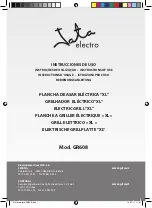
English - 5
T
EMPERATURE
G
UIDE
WARM
Crisping; keeping meats, casseroles and vegetables warm for
serving
SIMMER
Simmering and warming leftovers, preparing frozen foods, heating
soups, cooking casseroles, puddings, cereals, baking apples,
braising
250°F/120°C Scrambling and frying eggs, roasting meats and poultry
300°F/150°C Frying bacon and sausage
325°F/162°C Browning meats and poultry; frying fish, ham, chicken and
potatoes
350°F/175°C Grilling French toast and pancakes
375°F/190°C Grilling sandwiches
400°F/205°C Searing meats
R
OASTING
G
UIDE
MEAT
INTERNAL TEMPERATURES
Beef
Rare
140°F/60°C
Medium
160°F/71°C
Well
170°F/76°C
Pork
Fresh
170°F/76°C
Smoked
160°F/71°C
Canned
140°F/60°C
Lamb
170°F to 180°F/76°C to 82°C
Veal
170°F/76°C
Poultry
180°F/82°C
Beef, pork, lamb, veal and poultry can be roasted in the skillet.
Follow these basic guidelines for roasting:
1. To help seal in natural juices, roasts should be browned in the skillet before
roasting. Simply preheat the skillet, uncovered, at 325°F/162°C and add the roast.
Brown as desired on all sides. After the roast is browned, lay it in the skillet with the
fat side up. Season as desired.
2. Insert a meat thermometer into the thickest part of roast, making sure that it does
not touch a bone or rest in fat. Cover the skillet and roast at 250°F/120°C. If the
spattering of juices becomes excessive during the roasting period, reduce the
temperature setting to “SIMMER”. A small amount, no more than ½ cup, of water
may be added, if desired.
3. Roast meat to the recommended internal temperature, see the Roasting Guide.
Turn the temperature control to “OFF”. Avoid removing the cover too frequently
while roasting, as this will lengthen the cooking time. Remove the roast from the
skillet and let to stand for 10 minutes. Always use hot pads to remove the lid and
roast. The juices in the skillet may be used for gravy, if desired.






































